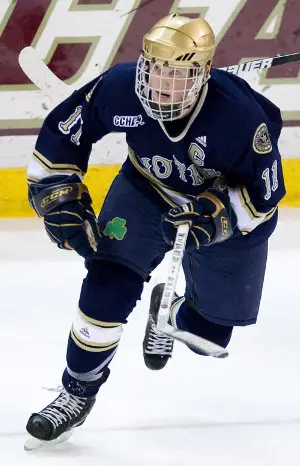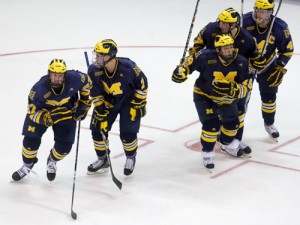Bruce Campbell said it best – if not a bit cryptically – in a recent Old Spice ad:
“If you have it, you don’t need it. If you need it, you don’t have it. If you have it, you need more of it. If you have more of it, you don’t need less of it. You need it to get it, and you certainly need it to get more of it … but if you don’t already have any of it to begin with, you can’t get any of it to get started, which means you really have no idea how to get it in the first place, do you?
“You can share it, sure; you can even stockpile it if you like, but you can’t fake it. Wanting it, needing it, wishing for it: the point is, if you’ve never had any of it, ever, people just seem to know.”
What is it? Experience, of course, and it becomes the hot intangible commodity at this time of year. Coaches, players, fans, the media? We all want to know who’s got it, who doesn’t, who has more, who has less. We all want to “seem to know.”
The Power of Experience
Like the saying goes, the games aren’t played on paper. That is to say that there are all sorts of extra factors that play a part in every game: fatigue, chemistry, injuries, incentive, mental and emotional states of the individuals and of the team. But every year as elimination time looms, experience becomes the buzz word.
It is seen as an unquantifiable but immensely potent possession, one that is accumulated through any number of different trials and tribulations. It focuses talent, it calms in high-pressure situations, it sharpens decision-making ability and generally negates the effects of “nerves.”
Older, veteran teams supposedly bathe in the stuff, and it allows them to excel against the odds — against more talented but less-seasoned squads, through adversities and challenges. Experience gives you a team full of captains, a single-minded organism composed of poise, leadership and the killer instinct.
Putting It to the Test
But for the sake of argument, let’s try to quantify experience, to see what it’s really worth. It’s a futile experiment in a scientific sense, but I think we’ll all agree that there’s merit and reason to the way I’m about to do this.
What generates experience? What do teams and individuals have to do to accumulate it? Well, depending on who you ask, it could be any of myriad different events and accomplishments, but I’ve picked out the big ones: raw playing experience, playing on a winning team, playing on a league champion — both regular- and postseason, playing in the NCAA tournament, and playing in the Frozen Four. Should I enter the national championship into that? Maybe, but winning two more games probably doesn’t really translate to that much extra experience. Just my opinion.
So let’s get down to business.
The Formula
It’s simple, though it definitely took some time. Let’s say Team X has a balanced six players from each class. Going into a season, that would be six points from the sophomores right off the bat — for playing one full season apiece — followed by another 12 from the juniors (two seasons under their belts), and 18 from the seniors. That’s 36 points for raw playing time.

Let’s say that two years ago, this team had a great record and won the league’s regular-season title, but flamed out in the conference tourney and missed the NCAAs. That happened when the juniors were freshmen, and the seniors were sophs, so that’s 12 combined points from those classes for the winning record and another dozen for the regular-season crown.
If that’s all this team has done in the last four years — we’ll pretend it really stunk the other two seasons — then the team has a total of 60 points. Divide it by the number of players (24), and you get the team’s average experience per player: 2.50.
Now let’s apply it to real teams.
Last Year’s Numbers
At the end of last season, following Boston University’s unbelievable national championship, Notre Dame actually carried the most experienced roster at 10.958 points per player. The Irish were followed by North Dakota (10.333), Air Force (10.136), Michigan (9.84), BU (9.833) and surprise Frozen Four qualifier Bemidji State (9.56).
Three more teams rounded out what appears to have been an Elite Nine, in Boston College, New Hampshire and Miami. All nine of these teams finished above 8.4 on my little scale, while the rest of the pack was a significant step below, at 7.2 and lower. Of the nine, only BSU had qualified for fewer than three NCAA tournaments in its last four years (the Beavers made it twice).
Six more teams formed that tier, between 6.95 and 7.2, followed by a steady decline from 6.35 down to the very bottom team — Robert Morris — at 2.038 experience points per player.
But what were the ultimately successful teams’ numbers at the beginning of the campaign? That’s really the point, so let’s take a look.
As of October 2008 …
… the numbers looked pretty different. The top six teams entering the season were all part of the aforementioned Elite Nine — North Dakota led off at 7.33, followed by Notre Dame, Boston College, Michigan, Air Force and New Hampshire — but the next three were Clarkson, Niagara and Colorado College. Eventual champion Boston University sat in 10th, but Hockey East and Frozen Four foe Vermont was halfway down the list at 22nd, and Northeastern — which had a spectacular run to the NCAAs last year — was way down in 41st.
Furthermore, the groupings were different at the start of the year. Instead of nine bunched at the top, it was only four. Air Force and UNH were stuck on a steep slope between the top quartet and the rest of the pack, and everyone else was below 5.2.
As of the end of the regular season …
… Niagara and Colorado College were still hanging tough in seventh and eighth, respectively. National runner-up Miami had climbed from 13th to 11th. The top 10 most “experienced” teams entering the postseason were North Dakota, Notre Dame, Boston College, Michigan, Air Force, UNH, Niagara, CC, BU and Bemidji State.
There were quite a few NCAA-qualifying teams who sat outside the nation’s top 16: Ohio State (45th), Minnesota-Duluth (33rd), Northeastern (30th), Vermont (22nd), Yale (21st), and Cornell (19th). Those in the top 16 who didn’t make it to the big dance: BC (3rd), Niagara (7th), Colorado College (8th), Clarkson (13th), Minnesota (15th) and St. Lawrence (16th).
How do teams as rich in experience as Boston College, CC and Minnesota get left behind, while such greenhorns as Ohio State, Minnesota-Duluth and Northeastern scrap their way in?
How do programs like Bemidji and Niagara — with all due respect — find themselves in such esteemed company, while 38th-ranked Harvard or 36th-ranked Massachusetts-Lowell are so far behind despite murderous league and non-conference schedules alike?
I declare shenanigans are afoot.
The Here and Now
So yes, last year’s all well and good, but what about this year’s crop?

As of the start of the NCAA tournament, Michigan and Bemidji are alone atop the experience mountain, at 10.24 and 9.96 points per player, respectively. Third-place Denver is exactly a point behind BSU, followed by Yale, UNH and Miami. Robert Morris is just barely edging last-place Michigan Tech, 2.14 to 2.12.
Some puzzling finds: Air Force and Notre Dame are eighth and ninth, but North Dakota is way down at 13th, St. Cloud State is 15th, Wisconsin 16th, and Alabama-Huntsville is 23rd. Two other current NCAA contenders fall outside the top 16 right now too, in Northern Michigan (19) and Alaska (25).
The defending national champs are golfing already, but still hold the 14th spot in the experience rankings.
Additional Twist
Just for grins, I also decided to calculate which teams had accumulated the most experience despite the youngest rosters. Your leaders? A familiar quartet, but scrambled a bit: BSU, Michigan, Miami and UNH topped the heap, with a significant break (for this measure) between Miami and UNH … but further down the list, there was another big disparity between No. 16 Colorado College and No. 17 Wisconsin.
Bringing It Home
So what’s the take-home message here? Is experience something that really matters going into a game, or is it just another way of tallying feathers (and near-feathers) in one’s cap?
To be sure, this isn’t the most comprehensive analysis that could’ve been done … but it certainly wasn’t a half-hearted attempt, either. There are many other factors that could be taken into account here — age, junior/prep experiences and achievements, games played rather than seasons, quality of opponents, etc. — but this is the data I have to work with and I don’t think it’s a bad first try.
Overall, it seems that experience is positively correlated with success, but which affects which is difficult to say. BU won it all last year — and in an ice-in-their-veins manner, I might add — despite barely cracking the Top 10. Miami was 60 seconds from the national title despite never having played in a Frozen Four before. And again, how do you explain Bemidji State? Or Alabama-Huntsville?
I think that the number of oddities in this investigation suggests that experience is overrated and clichéd; a valuable-but-not-critical aspect to victory that is called upon too often by those who want something to say but have nothing to say.
May the best teams win — not just the oldest.
Click here to see a spreadsheet of the raw data used in this analysis.


